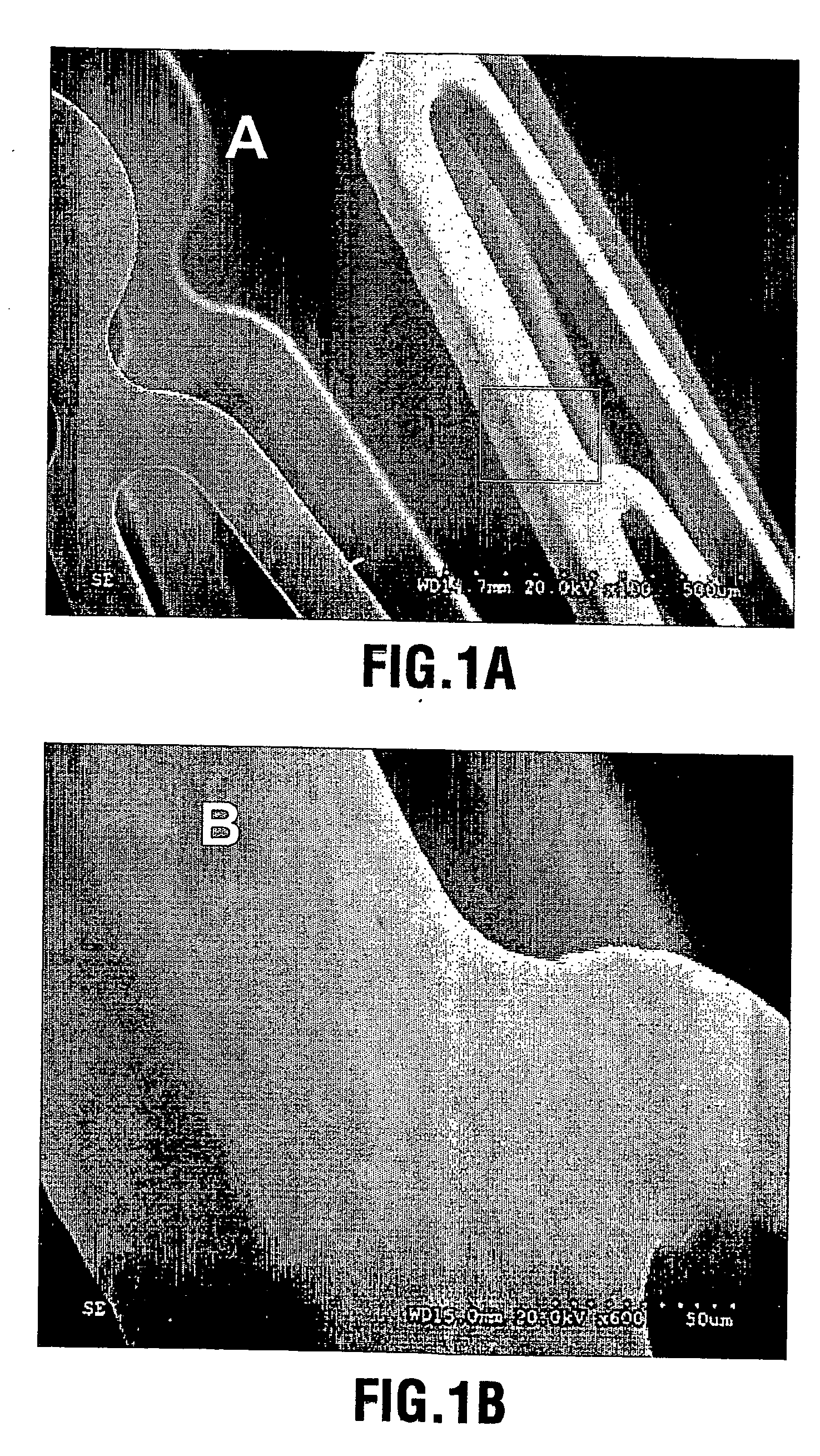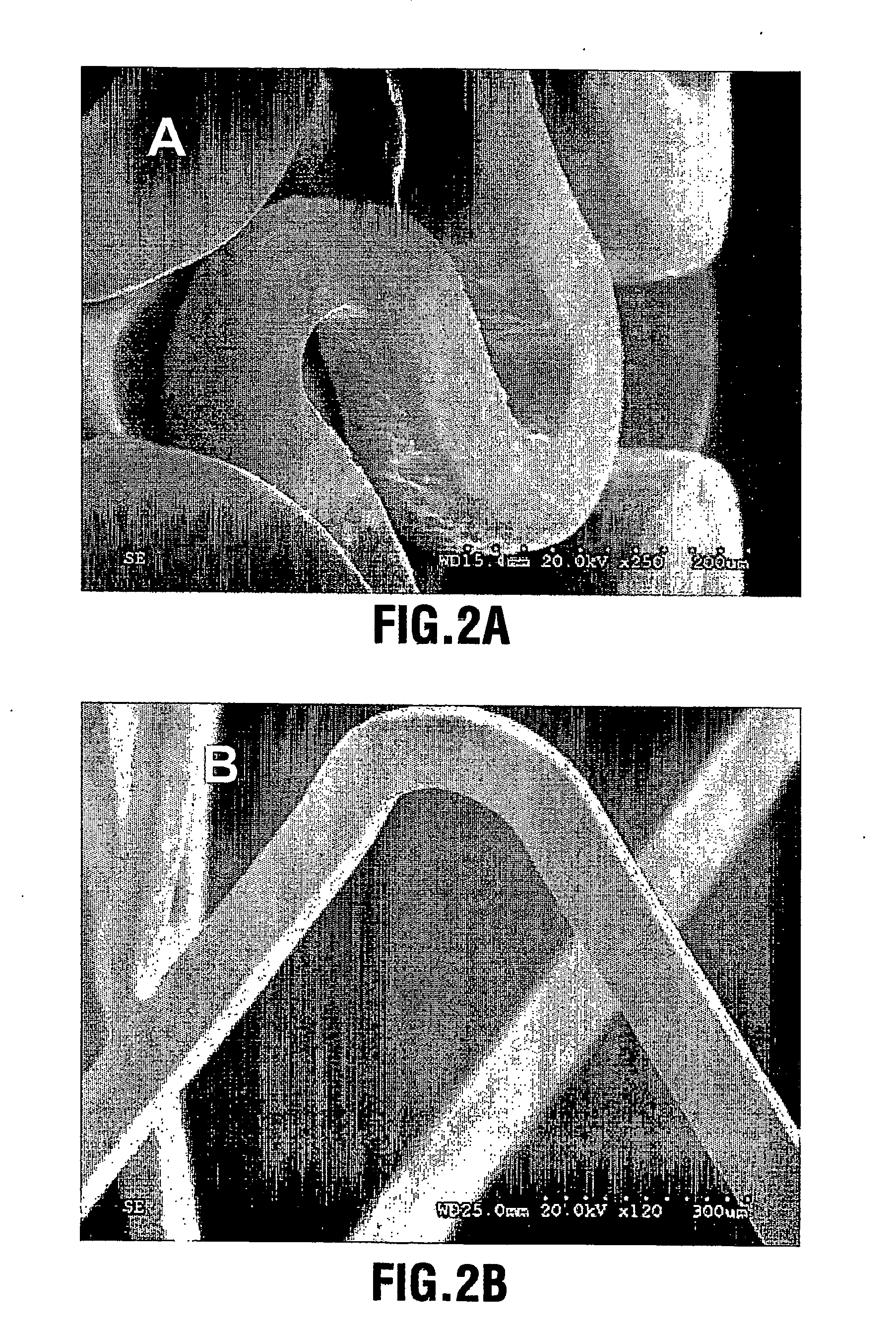Calcium phosphate coated implantable medical devices and processes for making same
a technology of calcium phosphate and implantable medical devices, which is applied in the direction of prosthesis, packaging foodstuffs, packaging goods, etc., can solve the problems of re-narrowing the vessel, damage is difficult to avoid completely, and the porosity of the calcium phosphate coating can be controlled, and the rate of drug release can be controlled
- Summary
- Abstract
- Description
- Claims
- Application Information
AI Technical Summary
Benefits of technology
Problems solved by technology
Method used
Image
Examples
example 1
[0062] In the first stage of the process, phosphite sol was hydrolysed in a water-ethanol mixture (a concentration of 3M) in a sealed beaker until the phosphite was completely hydrolysed (which is easily recognized by loss of a characteristic phosphite odour), at ambient environment. A Ca salt (2M) was then dissolved in anhydrous ethanol, and the solution was then rapidly added into the hydrolysed phosphite sol. The sol was left at ambient environment for 8 hours, followed by drying in an oven at 60° C. As a result of this process, a white gel was obtained. For the sol containing Ca / P ratio required to produce HA, the gel showed a pure (single phase) apatitic structure with a Ca / P ratio of 1.666, identical to stoichiometric HA, after calcining at a temperature as low as 350° C. Varying the Ca / P ratio allows other calcium phosphates, such as dicalcium phosphate (Ca / P=1) or tricalcium phosphate (Ca / P=1.5), to be obtained. A coating produced using this process, and applied to 316 SS su...
example 2
[0063] In another variant of the process, a pure water-based environment was used. The aqueous-based sols were prepared in the same manner as described above in Example 1 for the ethanol-based system. A higher rate of hydrolysis of the phosphite sol was observed. The mixed sol was dried while stirring. After 8 hours aging, a white gel appeared. For the sol containing a Ca / P ratio required to produce HA an apatitic structure with Ca / P ratio of 1.663, close to stoichiometric HA, resulted after calcining the gel at a temperature of 350° C. Both the ethanol-based and aqueous-based gels showed essentially the same apatitic structure at relatively low temperatures. This invention provides a method of synthesizing the HA ceramics via an aqueous-based sol-gel process.
example 3
[0064] A CaP coating was deposited on the surfaces of a group of electropolished stainless steel stents through aerosol-gel processing. The stents were first treated in 2.4 N phosphoric acid solution for 10 minutes at 70° C. to clean the surface and produce microroughness for increased bonding of the coating. The treated stents were ultrasonically cleaned and dried. The CaP sol was prepared by (a) hydrolysing a phosphor precursor (phosphite); (b) adding a calcium salt precursor to the medium after the phosphite has been hydrolysed to obtain a calcium phosphate sol such as a hydroxyapatite sol. The sol was atomized into ˜4 μm large particles using ultrasonically assisted atomizer, and the resulting aerosol fed into a coating chamber. This specific deposition technique is referred to as Aero-Sol-Gels (ASG) deposition and the resulting hydroxyapatite film as ASG-HA.
[0065] The clean stent was inserted into the coating chamber filled with flowing CaP aerosol-gel for a period of 30 secon...
PUM
| Property | Measurement | Unit |
|---|---|---|
| thickness | aaaaa | aaaaa |
| thickness | aaaaa | aaaaa |
| thickness | aaaaa | aaaaa |
Abstract
Description
Claims
Application Information
 Login to View More
Login to View More - R&D
- Intellectual Property
- Life Sciences
- Materials
- Tech Scout
- Unparalleled Data Quality
- Higher Quality Content
- 60% Fewer Hallucinations
Browse by: Latest US Patents, China's latest patents, Technical Efficacy Thesaurus, Application Domain, Technology Topic, Popular Technical Reports.
© 2025 PatSnap. All rights reserved.Legal|Privacy policy|Modern Slavery Act Transparency Statement|Sitemap|About US| Contact US: help@patsnap.com



